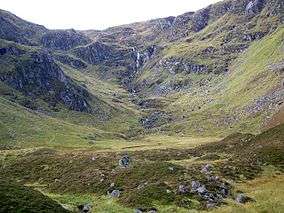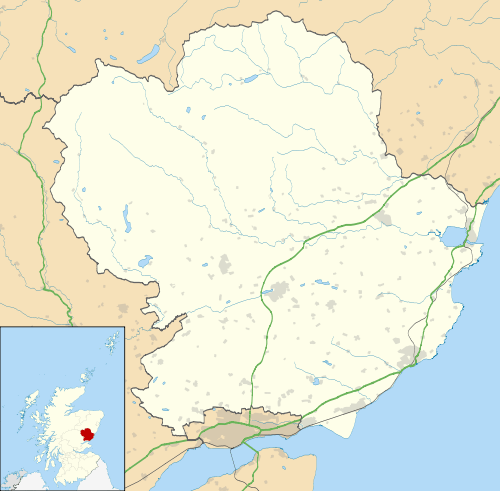Corrie Fee National Nature Reserve
| Corrie Fee National Nature Reserve | |
|---|---|
 The Corrie of Fee | |
 | |
| Location | Kirriemuir, Angus, Scotland |
| Coordinates | 56°51′41″N 3°13′44″W / 56.86139°N 3.22889°WCoordinates: 56°51′41″N 3°13′44″W / 56.86139°N 3.22889°W |
| Governing body | Scottish Natural Heritage (SNH) |
| Corrie Fee | |
Corrie Fee is a glacier-carved corrie-or "cirque"- situated at the head of Glen Clova in the Angus Glens of Scotland. It forms part of Corrie Fee National Nature Reserve (NNR), which is managed by Scottish Natural Heritage (SNH) and lies within the Cairngorms National Park. The adjoining Corrie Sharroch and the slopes of Craig Rennet are also in the NNR.
Glacial Features
Corrie Fee itself is one of the best examples of a glacial corrie in the British Isles, with a natural amphitheatre of cliffs. Corrie Fee is a classic example of a corrie, formed by the action of glaciers at the end of the last Ice Age.
At Corrie Fee, small independent glaciers cut corries during the last period of the Ice Age, called the “Loch Lomond Re-advance”, when the weight and movement of the ice ground out the bottom and wore back the sides of the corrie to produce the steep, U-shape amphitheatre of cliffs evident today. The glaciers deposited the eroded spoil as moraines. There are several types of moraine on the corrie floor, including lateral boulder moraines, fluted moraines below the corrie lip, and hummocky moraines. These moraines have forced the Fee Burn to cut a highly meandering path across the corrie floor.[1]
Flora and fauna
The Reserve is famed for the most extensive stand of montane willow scrub in Scotland and for the many arctic-alpine plants that grow on the cliffs and wet flushes in the corrie. Botanists have known of the importance of the area since the 18th century, and today it is recognised and protected as a national and internationally important site.
Montane willow scrub is one of the UK’s most rare and endangered habitats and is largely confined to the higher mountains of the Scottish Highlands where it is a relict of post-glacial vegetation. Montane willow scrub grows on moist, relatively base-rich soils in rocky situations on mountains but its distribution is restricted by grazing and it only survives on ungrazed ledges and on lightly grazed, steep rocky slopes or boulder fields, usually as small, discrete stands or more scattered bushes. Corrie Sharroch has the most extensive stand of montane willow scrub in the country.[2]
Designations
Corrie Fee is a National Nature Reserve, lying within the Caenlochan Special Area of Conservation,.[3] It is also designated as a Site of Special Scientific Interest and a Special Protection Area for the upland breeding birds.
References
External links
| Wikimedia Commons has media related to Corrie Fee. |
- Corrie Fee - Scottish National Heritage